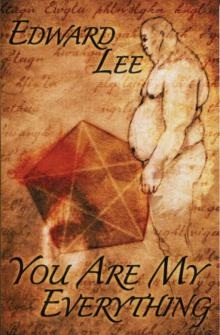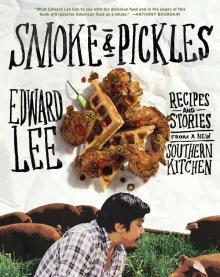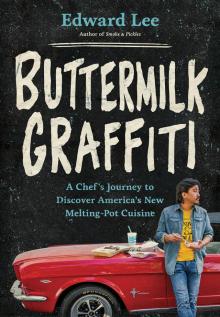- Home
- Edward Lee
Smoke and Pickles Page 2
Smoke and Pickles Read online
Page 2
That evening, it came to me in the form of rémoulade. I don’t even remember what it was for, just that I’d never had anything like it before: creamy, crunchy, sweet, and sour. I lapped it up, thinking, “What in Buddha’s name is this tongue-coating goodness?” It reinforced that nagging suspicion I had that things were indeed better on the other side. We ate mayonnaise; white people ate rémoulade. What other luxuries was I missing? Things I didn’t even know existed that other people were taking for granted. I slept restlessly that night and almost every night thereafter for a long time. Somewhere in the folds of that little brain of mine, something clicked, and I knew I would spend the rest of my life chasing the seduction of food. I’d never seen a restaurant kitchen or handled a chef’s knife, but I knew I wanted to. I also knew that it would upset the universe my parents had laid out for me. It would make me different, and friends would be hard to come by. Life would become a struggle to find that magical intersection between rice and rémoulade, between the two disparate cultures that overlapped inside me, somewhere neither here nor there, at once flawed and yet desirable. A place like a kitchen.
The recipes in this book are as much about stories as they are about flavors. As I grew up and learned the history of cooking in America, I realized that I was not unique in my discovery of cuisine through the lens of another culture. Evan Jones, author of American Food: The Gastronomic Story, described this as “the pattern of bringing from abroad new ways of cooking to be incorporated into an American style that has been evolving since the arrival of the first settlers.” So it is as natural for me to baste with fish sauce as it is to cook with Coca-Cola. Both worlds stand at arm’s reach.
Most of the chapters in this book start with a recipe (or two) that I call, simply, a rice bowl. There are infinite variations. Rice for me is a blank canvas; how you decide on the toppings says a lot about who you are. For me, a rice bowl is both literal and metaphorical, a natural way to express my cuisine. It represents a humble, everyday sort of meal, but I enliven it with modern techniques, global flavors, unusual pairings—basically the sum of everything I’ve learned and continue to learn. And it is not complete without some sort of a rémoulade on top. After you try a few of my creations, I know you’ll get inspired to come up with your own variations defined by your own journey. The chapters are organized so the lighter recipes appear first, followed by those with more complex, bigger flavors. Some of the dishes go best with wine, some with beer, and I give you suggestions where appropriate for both what to drink with the dish and what to serve it with. But feel free to do your own thing. I trust you.
I can’t stand the word “fusion,” not only because it is dated, but also because it implies a kind of culinary racism, suggesting that foods from Eastern cultures are so radically different that they need to be artificially introduced or “fused” with Western cuisines to give them legitimacy. For as long as I have been cooking in restaurants, it has been common practice for the cooks and waiters to sit down at staff meal and flavor our suppers with curry, salsa verde, soy sauce, Tabasco, mayo, teriyaki, melted butter, and that dreaded plastic bottle of “rooster sauce” (i.e., Sriracha) that exists in every restaurant kitchen. I’ve always found it funny that we prefer to eat this way, but once the restaurant doors open, we revert to serving a cuisine hampered by traditions and limitations that never acknowledged the modern flavors being embraced by young chefs.
If it is part of our vernacular, then it is part of our pantry. That’s a simple mantra that I’ve tried to follow in my cooking, both at home and at the restaurant. Why exclude anything? If I like pork rinds and I like raw tuna, well, I’ll be damned if they don’t find a way into a dish together. It isn’t forced. My culinary vernacular is broad, and it grows all the time. For now, I surround myself with the bounties of the South and reach back to my roots and to my experiences as a young chef in NYC. That is my story and these are my recipes. I hope you enjoy them.
Recipe for an Imperfect Bowl of Rice
The goal when cooking rice this way is to achieve a thin layer of toasted crust in the bottom of the pot. The crispy layer in contrast with the fluffy layer of rice on top is a sumptuous combination. I use a 10-inch cast-iron skillet. You could seek out a stone rice crock like the ones they use in Korean restaurants, but the cast-iron pan works just fine. Make your favorite toppings while the rice is cooking. When the toppings are ready, divide the warm rice, crunchy bits and all, among rice bowls and serve. / Makes enough for 4 large rice bowls or 6 appetizer-sized ones
2 cups Asian long-grain rice
1 teaspoon salt
1Place the rice in a large bowl and fill the bowl with 4 cups cold water. Using your hands, stir the rice in circles until the water turns cloudy. Drain the rice in a strainer, then return to the bowl and add another 4 cups cold water. Allow the rice to soak for 30 minutes.
2Drain the rice in the strainer again and shake to release the excess water. Transfer the rice to a 10-inch cast-iron skillet. Add 3 cups cold water and the salt and give it a nice stir. Bring the water to a simmer over medium-high heat. Turn the heat as low as you can, cover the skillet with a tight-fitting lid, and cook for 18 minutes. Turn off the heat and allow the rice to rest for 10 minutes, with the lid still on.
3Take the lid off the skillet, turn the heat on to medium, and cook the rice, without stirring, for 3 to 5 minutes, until the rice on the bottom of the pan turns amber and crisp. You can keep the rice warm in the skillet until you are ready to serve.
Master Recipe For Perfect Rémoulade
Don’t be dismayed by the long list of ingredients. All you have to do is throw them all into a bowl and mix them together. This is a master recipe, which means that once this base is done, you can flavor it any way you want. Have fun with it. Use it on everything from burgers to raw vegetables. If you can, make it a day in advance; the flavors will harmonize overnight. / Makes about 3 cups
2 large eggs
1¼ cups mayonnaise, preferably Duke’s or homemade
⅓ cup finely chopped shallots
½ cup chopped pickled okra (substitute chopped cornichons if you don’t have pickled okra)
2 garlic cloves, grated (use a Microplane) or finely minced
1 tablespoon prepared horseradish
2 teaspoons fresh lemon juice
2 teaspoons chopped fresh tarragon
1 teaspoon chopped fresh flat-leaf parsley
1½ teaspoons grainy mustard
1 teaspoon ketchup
¾ teaspoon Worcestershire sauce
¾ teaspoon sweet paprika
¼ teaspoon cayenne pepper
¾ teaspoon kosher salt
½ teaspoon sugar
½ teaspoon freshly ground black pepper
Grated zest of 1 orange
Grated zest of 1 lemon
3 dashes Tabasco sauce
1Put the eggs into a small pot of water and bring to a boil over medium heat. Boil for 4 minutes, then drain and immediately transfer to an ice bath to chill. Drain.
2Peel the soft-boiled eggs and add to a large bowl. Beat with a whisk; the yolks will still be runny. Don’t worry if it’s lumpy. Add all the remaining ingredients and mix well with a wooden spoon until the mixture is thick enough to coat the spoon but runny enough to pour out of the bowl. Transfer to a jar and chill in the refrigerator for at least 1 hour before serving. The rémoulade will keep in the refrigerator for up to 5 days.
Lamb & Whistles
My relationship with food developed in three stages: (1) as a memory, (2) as a history, and (3) as an ingredient. Take lamb, for instance. The first memory I have of it is eating it with my sister. Growing up, we never ate lamb. It is not a staple in Korean cuisine, which is odd to me, because lamb goes so well with Korean condiments. It would never have occurred to me to try lamb if not for my sister. She was the adventurous one.
On weekends, she and I wou
ld take the subway from Rockaway Parkway to Penn Station and walk eight blocks to the Twenty-sixth Street garment factory our parents managed. You’d call it a sweatshop today, and it sounds horrible to say I spent my childhood weekends in a sweatshop, but it wasn’t so bad. I played on the garment racks and spools of plastic dress covers; I ran up and down the fire escapes; and for lunch, Mom would give us each $10 to buy our own meal. For a kid who’d subsisted on rice and cabbage all week, this was a serious treat. We’d come back with burgers or hot dogs, sometimes Chinese food, and Mom would steal a few bites when no one was looking.
My sister was a troublemaker. Every lunch, we’d inch closer to Penn Station, even though (or because?) we’d been told to stay away. This was the 1980s, when Penn Station was rife with drug addicts, swindlers, and criminals of all shades. Every other shop sold porn, and the drunks were already well on their way. It was the weekend, after all. One Saturday, to my mom’s horror, we came back with two lamb gyros from the Greek diner. That was bad because (1) Mom knew we’d gone to Penn Station, and (2) she hated lamb. She scolded us and made us promise we’d never go back. She told us lamb was dangerous. She told us it was dirty. But it was too late: I was already hooked. Every weekend became a mission dedicated to finding how to sneak a gyro for lunch without Mom knowing. It’s touching now to think back on the way my sister would pull me through a crowd of con artists, drunks, and hookers for our gyro fix. Taped to the greasy tile wall of the diner was a frayed poster of a pretty blond girl eating a Kronos gyro. It was the first thing we’d see as we stepped into the vestibule. My sister would fight her way to a seat at the counter and order us one gyro, extra meat, extra yogurt sauce, extra hot sauce. We’d split it in half and eat it while looking out over a sea of yellow cabs. Then we’d come back to the sweatshop with slices of pizza we had no appetite for. That was her idea. My sister was the brilliant one.
That is, until she got greedy. Of all the scoundrels populating Penn Station, the dirtiest of all was the three-card monte dealer. Three cards: two black suits and one red suit; a cardboard box for a table; a couple of shills—and you’re in business. “Follow the red, not the black.” It was wrong, but if we won, we would double our money, not have to split the gyro, and still have leftover cash for a rainy day. “Follow the red, not the black.” My sister stood there clenching both bills, watching the dealer’s hands as the shills were winning $40, $60 hands. “Follow the red, not the black.” How could anyone lose? All one had to do was point to the red card, wait for the dealer to turn it over, and get paid. He wasn’t even shuffling very fast. It was easy, too easy. The red card was in the center. It had to be—I’d just followed it with my own eyes. I turned to my sister and pointed. And I saw my lunch money go down on the box, and the ten of spades looking up at the sun. We heard a loud, piercing whistle and, just like that, we were alone on the street corner, stunned, broke, and hungry. From where we stood, we could see the Greek diner. And all the tears in the world wouldn’t buy us lunch. We made up a story about dropping our lunch because a car almost hit us. My sister’s idea again. Then we sat on a box of cheap dresses and quietly ate bowls of rice and cabbage.
I didn’t eat lamb for a long time after that. The next time was in France. I was a cook by then, spending a summer in France traveling through the countryside on my way to Annecy so I could dine at Marc Veyrat’s three-star Michelin restaurant. I got a gig at Tante Alice, a quaint little bistro in Lyon where Pierre Gagnaire had gotten his start as a very young chef. There was a picture of him on the wall behind the bar; I can’t say if it was really him or not, but I liked the story. The food was fine but uninspired. The chef was more interested in practicing his English with me than in cooking. After two weeks, sensing my boredom, he sent me to a large brasserie where they rolled out hundreds of covers at both lunch and dinner. At a place like that, you learned to get a quenelle right the first time, every time. The cooks there weren’t too fond of me. They said I was just there to learn a few tricks and go back to the States to whore out their recipes for money. They used prostitution as a metaphor for everything. I wasn’t getting paid for my work, but every few days, the chef there would give me a little scratch money for beers. I’d save the cash and steal a few swigs of warm pastis from the pantry instead.
The Sunday after I started there was my first day to explore the city of Lyon. It was the gastronomic heart of France, the home of Bocuse, with the best farmers’ markets in the country. I’d made a list of everywhere I wanted to visit. It was my only chance to see the city, because in a few days I had to move on to Marseilles, to a seafood restaurant. I was to work in Marseilles for a week before heading to Provence and then to my final destination of Annecy. I showed the cooks my itinerary for Sunday and they cheered me on—better than spending money on a whore, they said. Saturday night, I went to bed like it was Christmas fucking Eve.
If you know anything about Lyon, then you know that everything shuts down on Sunday: all the markets, bakeries, wine shops, and any restaurant worth eating at. I walked for hours with my itinerary slowly turning into a crinkled ball in my clenched fist. This was the cooks’ idea of a good joke. Finally I wandered into a busy-looking neighborhood of North African immigrants. I waited in line for thirty minutes at the tabac just to smoke some cigarettes—I was that pissed. By the time I found a place to eat, I didn’t care that it was a Moroccan joint run by Algerians. I just sat and ate. I ate braewats and bisteeya and a lamb broth that was so good I nearly fell out of my chair. I smoked and drank tea and listened to cryptic arguments in a language so foreign it sounded like dust. I went home briefly and came back in a few hours for dinner. I ate a lamb tagine and more braewats and something that resembled baklava but was much sweeter. It was one of the best meals I had in France. Maybe ’cause I was so hungry. Maybe ’cause it just was. It was lamb in the context of North African history; it was lamb the way they must have eaten it for generations. It was their story; I just got to eavesdrop.
The next day, the cooks at the brasserie asked me jokingly how my day off was. I told them to fuck off, and I left a day early for Marseilles so I wouldn’t have to say good-bye. I made it to Provence and all the way to Annecy and cooked at Le Belvédère for a week before going to Veyrat’s L’Auberge. I treated myself to a long dinner and enjoyed it, but in the way you enjoy something because you know it is costing you so much money. There was lamb on the menu, but I didn’t order it. I got the squab instead.
After that, I cooked a lot of lamb, but most of it was mimicry, be it a tagine or a navarin. It only became an ingredient for me after I spent a day with Craig Rogers on his farm in Patrick Springs, Virginia. The flavor of Craig’s lamb is unlike anything I’d ever thought of as gamey. Even my mom likes it. It does not need to be boiled for days in perfumed spices. It is a pristine ingredient, and by that I mean a gift. When I first tasted Craig’s lamb, it was so mild and creamy and herbaceous that I started to imagine all the different flavors it could play with. It became so much more than ground meat mixed with dried spices and cooked on a rotisserie. It compelled me. And that is how I learned to cook lamb, the long way. It makes me a late bloomer, I know, but sometimes that’s just how we have to learn.
Craig doesn’t rush himself either. He talks too much and that slows him down, but I like that about him. He gave me a demonstration of how to make sharp whistle calls and I watched his border collies react with military precision. It’s their primal instinct to control the flock, and the sheep are happy to oblige. How old is this relationship between dogs and sheep? Almost as old as domestication itself, as old as the first time man settled on a grassy knoll, as old as the first whistle call, as the first swindle. It’s funny to think this whole agriculture thing may have started with nothing more than an accidental whistle. Whistles, dogs, sheep, farms, food. Most likely that’s not exactly how it went, but it’s still nice to think about.
I made all the recipes in this chapter with Craig’s lamb. That’s important, becau
se unlike some of those earlier lamb preparations that were masked in heavy doses of spices, these are unadorned and simple. We’re lucky to have a lot of great lamb producers in the United States now. Try to buy lamb at a farmers’ market near you; you want lamb that has grazed on grass, that is hormone free, and that has been raised humanely, not penned. The meat will be slightly paler than commercial lamb, and it should be lean and smell clean.
Good cooking is always simple—not always convenient, but always simple. That’s a mantra I’ve followed over the years. Oh, and the other one is this: Never trade your lunch money for a sleight of hand.
Rice Bowl with Lamb and Aromatic Tomato-Yogurt Gravy

 In the Year of Our Lord 2202
In the Year of Our Lord 2202 The Minotauress
The Minotauress Terra Insanus
Terra Insanus The Stickmen
The Stickmen Flesh Gothic by Edward Lee
Flesh Gothic by Edward Lee Family Tradition
Family Tradition You Are My Everything
You Are My Everything The Backwoods
The Backwoods The Teratologist
The Teratologist Smoke and Pickles
Smoke and Pickles Buttermilk Graffiti
Buttermilk Graffiti Dahmer's Not Dead
Dahmer's Not Dead Quest for Sex, Truth & Reality
Quest for Sex, Truth & Reality The Innswich Horror
The Innswich Horror Brides Of The Impaler
Brides Of The Impaler Goon
Goon Trolley No. 1852
Trolley No. 1852 Sacrifice
Sacrifice Monster Lake
Monster Lake Succubi
Succubi Lucifer's Lottery
Lucifer's Lottery Monstrosity
Monstrosity The House
The House The Dunwich Romance
The Dunwich Romance Operator B
Operator B Bullet Through Your Face (improved format)
Bullet Through Your Face (improved format) Grimoire Diabolique
Grimoire Diabolique Room 415
Room 415 The Messenger (2011 reformat)
The Messenger (2011 reformat) Incubi
Incubi The Black Train
The Black Train House Infernal by Edward Lee
House Infernal by Edward Lee City Infernal
City Infernal Creekers
Creekers The Haunter Of The Threshold
The Haunter Of The Threshold Mangled Meat
Mangled Meat The Doll House
The Doll House Header 2
Header 2 Bullet Through Your Face (reformatted)
Bullet Through Your Face (reformatted) Header 3
Header 3 Infernal Angel
Infernal Angel Pages Torn From a Travel Journal
Pages Torn From a Travel Journal Edward Lee: Selected Stories
Edward Lee: Selected Stories The Bighead
The Bighead The Chosen
The Chosen